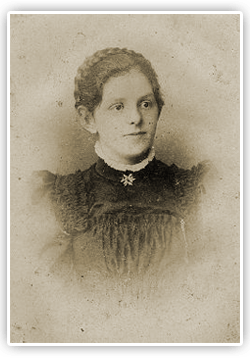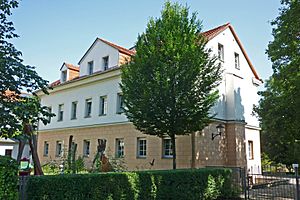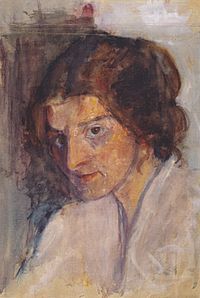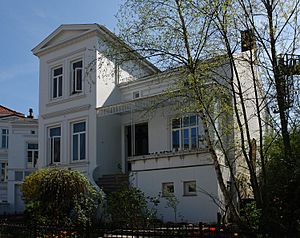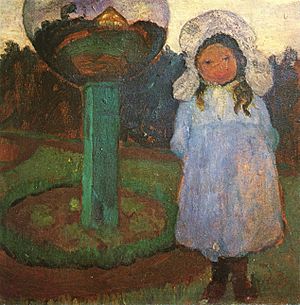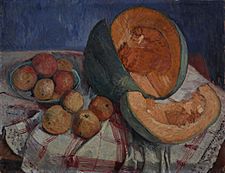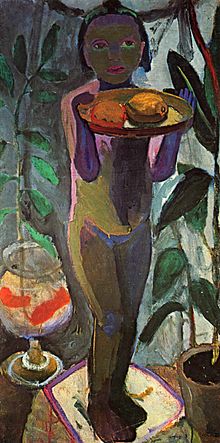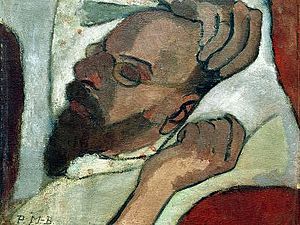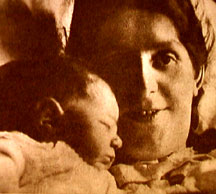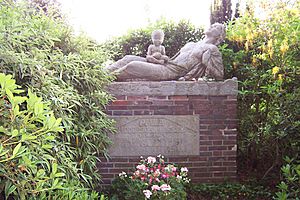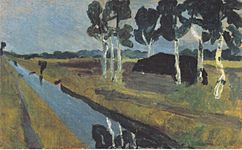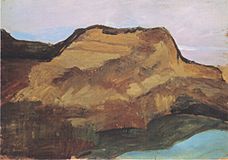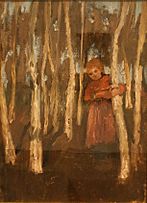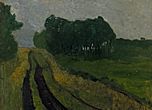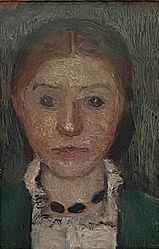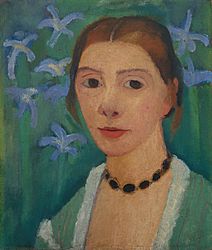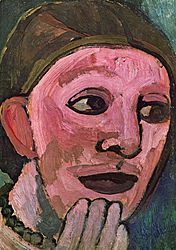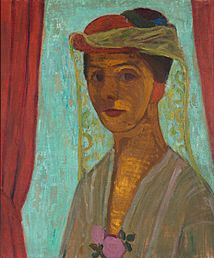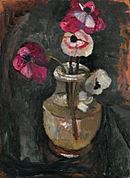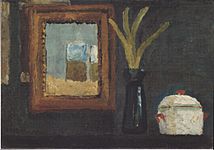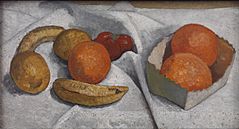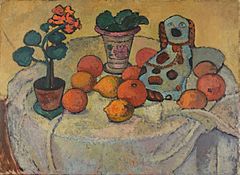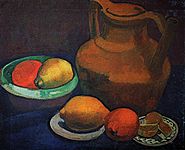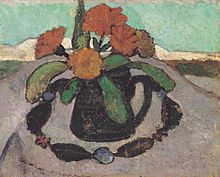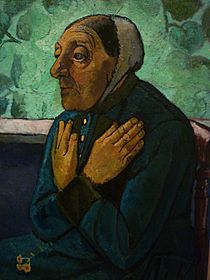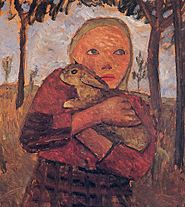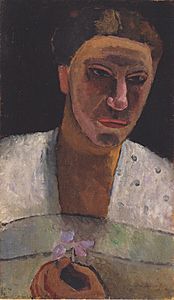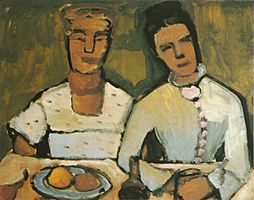Paula Modersohn-Becker facts for kids
Quick facts for kids
Paula Modersohn-Becker
|
|
|---|---|
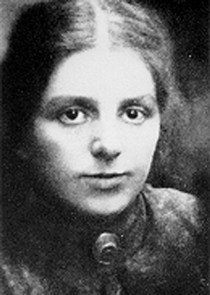
Paula Modersohn-Becker, year unknown
|
|
| Born |
Minna Hermine Paula Becker
8 February 1876 Friedrichstadt (Dresden), German Empire
|
| Died | 20 November 1907 (aged 31) Worpswede, German Empire
|
| Nationality | German |
| Occupation | Artist, painter |
| Years active | 1895-1907 |
| Known for | Expressionism |
| Spouse(s) |
Otto Modersohn
(m. 1901) |
| Children | Mathilde Modersohn |
Paula Modersohn-Becker (8 February 1876 – 20 November 1907) was a German Expressionist painter of the late 19th and early 20th century. Her work is noted for its intensity and its blunt, unapologetic humanity, and for the many self-portraits the artist produced. She is considered one of the most important representatives of early expressionism, producing more than 700 paintings and over 1000 drawings during her active painting life. She is recognized both as the first woman to have a museum devoted exclusively to her art (the Paula Modersohn-Becker Museum, founded 1927).
Her career was cut short when she died from postpartum embolism at the age of 31.
Biography
]
Becker was born and grew up in Dresden-Friedrichstadt.
She was the third of seven children in her family. Her father, Carl Woldemar Becker (1841–1901), the Odessa born son of a Russian university professor of French, was employed as an engineer with the German railway. Her mother, Mathilde (1852–1926), was from the aristocratic von Bültzingslöwen family, and her parents provided their children a cultured and intellectual household environment.
Despite these advantages of family, the Beckers found themselves in socially constrained circumstances. In 1861, Oskar Becker, Carl's brother, in an unsuccessful assassination attempt, had shot King Wilhelm of Prussia in the neck. The King was not severely injured, and Oskar was pardoned five years later for the crime (on conditon that he permanently leave the country), but the constraints of opportunity for Carl Becker's family would linger.
In 1888 the family moved from Dresden to Bremen, where Carl Becker had obtained a position on the building board of the Prussian Railway Administration. The family interacted with Bremen's local artistic and intellectual circles, and Paula began to learn to draw. In the summer of 1892, her parents sent her to relatives in England to learn English. While living with a maternal aunt in London, Becker received her first instruction in drawing at St John's Wood Art School.
After returning to Bremen, she studied at a teacher's seminary from 1893 to 1895, as her father wished (two sisters also attended this program). Concurrently she received private painting lessons from local German painter Bernhard Wiegandt.
She worked as a painter from ~1893, at age 16, and was allowed to set up her first studio in the extension of her parents' house in Bremen (now Haus Paula Becker, with Becker's early studio intact). From this period comes a series of portraits of her siblings and also the first self-portrait (1893). She completed her teacher's course "with flying colors," but it was clear that she had little intention of pursuing a career in that profession.
In the spring of 1896, Paula was able to travel to Berlin to take part in a six-week drawing and painting course organized by the Berlin Artists' Association (Verein der Berliner Künstlerinnen), again, staying with members of her mother's family while completing her course. After graduating, she stayed on in Berlin, and in February 1897 was admitted to the first class of painting at the Women's Academy. Paula additionally used her Berlin time to visit its art museums, studying the works of German and Italian artists. An encounter with an important proponent for German feminism, Natalie von Milde, made a deep impression, although swift intervention from her family cut that connection short.
After these years of study, Becker returned to Bremen. She convinced her family to allow her to attend a further course of study at the nearby artists’ colony in the northern German town of Worpswede.
Worpswede
Becker had become familiar with the Worpswede colony as early as 1895, when Fritz Mackensen, Otto Modersohn, Fritz Overbeck and Heinrich Vogeler presented their paintings in Bremen's Art Museum, Kunsthalle Bremen. The colony had begun when Mackensen and Heinrich Vogeler had retreated to the countryside, partly as a protest against the domination of the art academy style and life in the big city, but also, and, not incidentally, to save on expenses.
In 1898, as a pupil of Mackensen, Becker joined the Worpswede group. She created "sentimental" landscapes and scenes of peasant life, painting, in the Worpswede manner, the local farmers and northern German landscape. At this time she began close friendships with the sculptor Clara Westhoff (1875–1954), the painter Ottilie Reylaender (1882-1965), and the poet Rainer Maria Rilke (1875–1926). It was quickly evident, however, that Worpswede was not suited to Becker's rapidly developing artistic style. In her journal, Becker wrote: "the way Mackensen portrays people is not broad enough, too genre-like for me."
Two paintings she exhibited at the Bremen Kunsthalle in December 1899 were sharply criticized and had to be removed during the exhibition, subject to a "hysterical" attack by the art critic Arthur Fitger (now regarded as having been more outraged by the inclusion of female artists in the show than in anything particular portrayed by the actual artworks). While the community at Worpswede "remained rooted in romanticized traditions of landscape, her own artistic interests were shifting noticeably toward Paris and leaving her feeling increasingly alienated.
Paris
Paris at the turn of the 20th century was the acknowledged epicenter of artistic exploration, and many artists of the time felt its pull. Westhoff, Becker's close friend, left Bremen in early 1899 to study in Paris with Auguste Rodin (Rilke went with her, serving for a time as Rodin's secretary). By December of that year, Becker, having come into a small inheritance, followed her friend there, and in 1900 she began study anatomy at the Académie Colarossi in the Latin Quarter. She also visited museums or exhibitions and galleries alone or with Westhoff to get to know modern French painters. She was particularly impressed by the paintings of Paul Cézanne and other members Les Nabis, who emphasized the importance of colored areas in paintings following the example of Paul Gauguin. "In her painting, she followed the inspiration of the contemporary artists she had encountered in Paris, moving increasingly far from the conventional painting her colleagues at Worpswede were producing." They inspired her to use simplified forms and symbolic, rather than naturalistic, colour.
In April 1900 the great World's Fair Centennial Exhibition opened in Paris. Otto Modersohn, a Worpswede painter who had been an on-and-off resident of the colony since 1897, arrived in town with mutual friends to attend. His sick wife Helene had remained behind in Worpswede, and she died during Modersohn's short time in Paris. Modersohn hurried back to Germany. Shortly thereafter, Becker returned to Worpswede herself. It was clear to Becker's parents that the two had become personally involved, but their disapproval was of little impact.
Marriage with Otto Modersohn
In May 1901, Becker and Modersohn married. Modersohn was 11 years older than Becker, with an infant daughter, Elsbeth. In the two years that followed, Becker tried to combine her responsibilities as wife, housewife and stepmother with her artistic ambitions. She set up a small studio on a nearby farm, where she went to paint for several hours a day. A series of paintings of children was created, among them Girl in the Garden Next to a Glass Sphere (1901–2), Portrait of a Girl (1901), Head of a Little Girl (1902). She functioned in this uneasy balance for two years, then returned again to Paris, accompanied by Otto, for two months in 1903. She spent most of her time drawing in the Louvre from ancient and Egyptian models. With Otto, she visited Auguste Rodin, also taking time to study the newly popular Japanese style and visit with painters Pierre Bonnard and Edouard Vuillard. In February 1905 Becker again returned to Paris. Otto briefly came to see her, and together they saw Paul Gauguin's paintings. After this visit, Becker "accepted the fact that modern artists such as Matisse, whose works fascinated her, had no appeal for Otto." She took drawing courses at the Julian Academy, but became increasingly aware that she had already developed her own painting style. After returning to Worpswede, her interest focused on still life. While before 1905 only ten still lifes can be traced in her work, from 1905 to 1907 there are almost 50. She and Modersohn lived mostly apart for the next two years, with 1906 marking an artistically productive year, spent mostly in Paris. During her stays in Paris in 1905 and 1906, she lived in her studio on Avenue du Maine, where she created, among other things, portraits of Clara (Rilke-)Westhoff and Clara's husband Rainer Mario Rilke.
1906: "I am becoming somebody"
In a letter to Rilke written from Worpswede on 17 February 1906, Becker wrote: "And now, I don't even know how I should sign my name, I'm not Modersohn and I'm not Paula Becker anymore either"." Less than a month later she wrote from Paris to her husband, "try to get used to the possibility of the thought that our lives can go separate ways". In 1906, Modersohn-Becker left Worpswede, as well as her husband, Otto, to pursue an artistic career in Paris. In a journal entry dated 24 February 1906, a sanguine Modersohn-Becker wrote, "Now I have left Otto Modersohn and am standing between my old life and my new life. I wonder what the new one will be like. And I wonder what will become of me in my new life? Now whatever must be, will be." Despite her sister's and mother's general disapproval of Paula's decision to leave Otto for Paris, her relocation there proved to be quite prosperous.
It was during this time frame that she accomplished her most intensive, and now most highly regarded, work. From this body of work she produced a series of paintings about which she felt great excitement and satisfaction. During her final trip to Paris in May of 1906, she wrote a letter to her elder sister, Milly Rohland-Becker, in which she stated, "I am becoming somebody – I'm living the most intensively happy period of my life."
Final year and death
In 1907, Becker returned to her husband in Worpswede, despite periodic correspondence that indicated her desire for independence. She had written in detail about her love for her husband but also of her need to delay motherhood in her pursuit of artistic freedom. She continued to express ambivalence regarding motherhood as she was concerned about her ability to paint while raising a child; her diary entries indicate that she had planned on achieving a painting career by age thirty, then having children. When her daughter Mathilde (Tillie) Modersohn was born on 2 November 1907, Paula and Otto were joyous.
She had complained of pain in her legs after the delivery, and was advised to remain in bed. When the physician returned on 20 November, he advised her to rise. She walked a few steps, then sat down, called for the infant to be placed in her arms, complained of leg pain, and died, saying only "What a pity".
Paula's death was likely due to deep venous thrombosis (DVT), a complication of pregnancy that is relatively common when women are set to bed for a long time after delivery, as was customary practice at that time. Apparently, a thrombus had formed in her leg, and with her mobility, broke off and then caused her death within hours.
She was buried in the Worpswede Cemetery.
Painting technique
Becker was trained in the methods of realism and naturalism, along with a recognizable simplicity of form.
She was able to achieve a distinct texture to her work by scratching into the wet paint. Modersohn-Becker employed the same technique throughout her short career as a painter. She worked in tempera and oil with a limited palette range of pigments such as zinc white, cadmium yellow, viridian, and synthetic ultramarine. She later abandoned those techniques to move into Fauvism. Fauvist influences appear in her works such as Poorhouse Woman with a Glass Bottle.
Influences
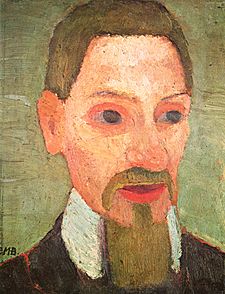
There is evidence to suggest that a number of Paula Modersohn-Becker's self-portraits were influenced by the Pre-Raphaelite painter Dante Rossetti, including Self-portrait with a bowl and a glass (c.1904; Sander Collection), Self-portrait ... with amber necklace (1906; Private collection), and Self-portrait on my sixth wedding anniversary (1906; Museen Böttcherstrasse, Paula Modersohn- Becker Museum, Bremen). She visited contemporary exhibitions often, and was particularly intrigued with the work of Paul Cézanne. Other Post-Impressionists were especially influential, including Vincent van Gogh and Paul Gauguin.
Influence
Becker may have influenced one or more of Picasso's paintings, as Diane Radycki posits in her 2013 monograph on the artist.
Legacy
By 1899 Clara Westhoff had made a bust of Modersohn-Becker, saying that it was a symbol of their friendship and shared passion for art. In 1908 Rainer Maria Rilke wrote the renowned poem "Requiem for a Friend" in Modersohn-Becker's memory.
Becker was not widely known at the time of her untimely death, and had sold few paintings during her lifetime. It was only thanks to exhibitions organized in the first years after her death that some collectors learned about her and began to acquire her paintings.
First woman to have a museum devoted exclusively to her art
In 1927 businessman Ludwig Roselius opened the Paula Modersohn-Becker Museum in Bremen. It was designed by Bernhard Hoetger, who had known Becker from Worpswede.
"Degenerate Art"
Local Nazis denounced the museum's art and architecture in 1935, but Roselius ignored this until Hitler denounced his entire Böttcherstraße in September 1936. After Roselius's secretary Barbara Goette intervened on his behalf with Hitler, the street's buildings were allowed to remain as a monument of "degenerate art".
But despite the survival of the architectural fabric of her museum, Becker's work did not escape the Nazis attention undamaged. In 1937, "70 of her paintings were purged from German museums, either destroyed or exhibited as 'degenerate art.'”
The Paula Modersohn-Becker Foundation
Mathilde Modersohn (1907–1998) founded the Paula Modersohn-Becker Foundation (Paula Modersohn-Becker-Stiftung) in 1978. To form the core of the foundation, Mathilde Modersohn donated more than 50 paintings and 500 drawings from her personal collection, which she had inherited through her mother's estate. The purpose of the foundation is to "enhance the knowledge of the artist by researching and cataloguing her complete works," and to protect the integrity of her corpus.
Paula Becker House
Modersohn-Becker's house in Bremen, where she spent much of her life, opened in October 2007 as a private art museum and gallery. The Becker family had moved from Dresden to Bremen in 1888 and lived in this house. Becker lived in the house until 1899 when she was 23 years old and set up her first studio here. There was an active artist community in Bremen and via Becker's mother's friendships in the art world, Paula grew to be part of this community.
In 2003, Heinz and Betty Thies bought the then-rundown house and had it restored in time for the 100th anniversary of the artist's death. At that time (November 2007), it was turned into a public museum.
Recent exhibitions
- Making Modernism: Paula Modersohn-Becker, Käthe Kollwitz, Gabriele Münter and Marianne Werefkin (12 November 2022 — 12 February 2023) Royal Academy of Arts, London
- These are my modern women: Trading Monet for Modersohn-Becker (20 February 2022 — 04 September 2022) Arp Museum Bahnhof Rolandseck
- Paula Modersohn-Becker (8 October 2021 — 6 February 2022) Schirn Kunsthalle, Frankfurt
- Paula Modersohn-Becker: An Intensely Artistic Eye (8 April 2016 — 21 August 2016) Musée d’Art moderne, Paris
- Paula Modersohn-Becker: Art and Life (February 2016 — 12 March 2016) Galerie St. Etienne, New York, NY
- Rebels and Martyrs: the image of the artist in the 19th century (opened 28 June 2006) National Gallery, London (first UK exhibition of Self-portrait at 6th Wedding Anniversary)
From a little-known artist with a complaining husband, the increasing exposure and popularity of Modersohn-Becker's work has kept some of her most popular paintings in constant international circulation during the 21st century.
Gallery
Landscapes
Self-portraits
Still lifes
|
Vase with anemones
(1904) |
Still life with a sugar bowl and hyacinth
in a glass (c. 1905) |
Still life with oranges, bananas, lemon and tomato
(1906) State Art Gallery in Karlsruhe |
Still Life with Oranges and Stoneware Dog
(1906-07) |
Still life with clay jug
(1907) |
Still life with marigolds in front of a landscape
(1907) |
Portraits
|
Elsbeth Modersohn on a red pillow (c. 1904)
|
Old Peasant Woman (c. 1905)
|
Klara Rilke-Westhoff (1905) Hamburger Kunsthalle
|
Elsbeth Modersohn with a rabbit(1905)
|
Lee Hoetger with flower
(1906) |
Lee Hoetger and her sister(1906-7)
|
See also
 In Spanish: Paula Modersohn-Becker para niños
In Spanish: Paula Modersohn-Becker para niños
- Der Blaue Reiter
- Die Brücke
- List of German women artists
- Selfportrait at 6th wedding anniversary


